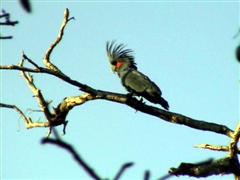Cockatoo - Palm
Black Palm Cockatoo Scientific Name: Probosciger aterrimus aterrimus
Sun, 13th July, 2025 - 6:58 am GMT
Sponsor Ads:

Alternative Name
Black Palm Cockatoo Scientific Name: Probosciger aterrimus aterrimusBasic Info
The Palm Cockatoo is perhaps best known for his striking grayish-black plumage and red cheeks. His cheeks will become a deep shade of red when he is excited. His erect crest is glorious, consisting of curved, backward rising feathers. His eyes are dark brown. He is a large parrot that on average will reach 24 inches (60cm) at adult hood with an impressive wingspan of 12 - 15.3 inches (305 mm - 390 mm). The females look the same as the males except their upper mandible is shorter. The upper mandible is also the best way to distinguish immatures. In the immatures it is pale, while in adults it is black. They have a red tipped black tongue.
Health
The Palm Cockatoo has a more specialized diet than many of the other parrot species. In addition to the varied diet recommended (pellets, fruits, nuts, berries etc) for other hook billed parrots, they also require the nuts Kamani and Pandanus. Breeding Information about breeding in aviculture was not found. In the wild the magnificent Palm Cockatoo will use existing nesting hollows of other birds. The female will lay only one single egg per clutch, with incubation taking approximately one month. Remarkably the fledgling period lasts 100 to 110 days. This is longer than any other parrot species.Habitat
They are well adapted to the tropical rainforest habitat.Behavior
The Palm Cockatoo can be described in one word- gorgeous. This striking cockatoo is perhaps the most unusual and beautiful of all cockatoos. Those lucky enough to own them should treasure these remarkable creatures. The Palm Cockatoo, also known as the Black Palm Cockatoo is loving and affectionate. His docile behavior makes him a wonderful pet. Unfortunately these birds have become very rare in the wild and therefore should not be kept singly; instead they should be kept in pairs for breeding purposes. Due to its endangered status the Palm Cockatoo is no longer imported and can only be obtained from domestic breeding programs. They should be kept only for breeding purposes. Unlike many other parrot species the Palm Cockatoo is a slow riser and is not very active in the morning. The Palm Cockatoo's wide range of vocalizations is noted in the literature. No mention of talking ability has been noted.Origin
AustraliaHistory
The Palm Cockatoo originates in areas of Australia (and surrounding Islands) and New Guinea.This is not the case for all other Cockatoo species who prefer dry habitats. The wild Palm Cockatoos roost and nest in large trees. These trees are a requirement for the wild Palm Cockatoo.Common Foods
N/ASponsor Ads:
During Britain's "brain drain," not a single politician left the country. -- Unknown
Cockatoo - Palm
Coded by: BGID® | ALL RIGHTS RESERVED Copyright © 2000-2025
Disclaimer | Privacy | Report Errors / Contact | Credits








 President of the United States of America - Real Estate mogul, Pageant owner and now one of the most controversial men in political history.
President of the United States of America - Real Estate mogul, Pageant owner and now one of the most controversial men in political history.  Global warming has been in and out as the "latest" hot topic for many years. It is, according to modern scientists, the result of man-made industrial pollutants, clearing forested areas, agriculture, etc. But now they are thinking it started way before the Industrial Revolution...
Global warming has been in and out as the "latest" hot topic for many years. It is, according to modern scientists, the result of man-made industrial pollutants, clearing forested areas, agriculture, etc. But now they are thinking it started way before the Industrial Revolution...  Politician, US Vice President and President of the USA - Joseph Robinette Biden Jr.
Politician, US Vice President and President of the USA - Joseph Robinette Biden Jr.  versus
versus  Russia: 'The Evil Empire'? Are they all that bad or is it just the USA trying to portray Russia as bad because they are a world power with land bigger and a society very different from the USA ideal?
Russia: 'The Evil Empire'? Are they all that bad or is it just the USA trying to portray Russia as bad because they are a world power with land bigger and a society very different from the USA ideal? 
 Corona virus
Corona virus 
 Users with wide screen monitors can benefit from more content on every page.
Users with wide screen monitors can benefit from more content on every page.